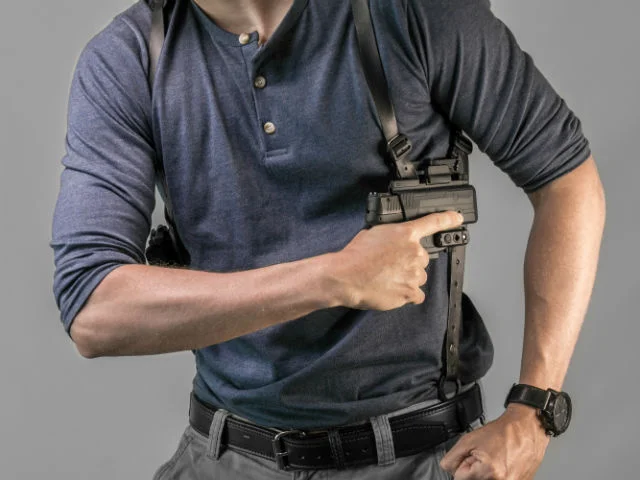
Top Tips For Shoulder Holster Concealed Carry
To get shoulder holster concealed carry, it takes a bit more than just throwing the holster on, putting on a jacket and heading out the door. Granted, maybe not a whole heck of a lot more!
It isn't that using a shoulder holster is like doing calculus or anything, but it's more that it takes a bit of fettling, a bit of tweaking and so on to get the best results.
Since we make shoulder holsters for concealed carry, here are some top tips we arrived at from development and using our shoulder holsters (and others!) and some things we've learned from others who've used them.
Shoulder Holster Concealed Carry: Make Good Choices To Start With
The first step in shoulder holster concealed carry is to make good choices to start with, meaning making a choice of gun and holster that's going to work for you right from the jump.
Why does that matter?
Given the way that shoulder holsters lay on the body, the margins for error are a little slimmer compared to trying to conceal a pistol and holster tucked inside the waistband.
For a shoulder holster to be comfortable to carry, the holster can't protrude into the armpit; you can't be walking around with one arm hunched up or else you're going to ditch your shoulder holster at the first opportunity.
To be concealable, the holster has to ride tight to the body so it doesn't stick out so far to the side that you have an obvious goiter.
And how does a person get that?
You start with a gun that's slim, and a holster that can be dialed in to fit correctly. Slim subcompacts like a S&W Shield or Sig P365 are great choices. Among full-size guns, a larger pistol with a slim slide such as a CZ 75 or a 1911 is very well-suited to use in a shoulder holster.
Get A Shoulder Holster That Can Be Adjusted

Just as with getting an IWB holster dialed in by finding the right spot on the body and waistband, you'll have to experiment with a shoulder holster until you find the right setting for comfortable carry and effective concealment.
Therefore, make sure you get a shoulder holster that can be adjusted.
Many on the market are one-size-fits all, which means they're a size that doesn't really fit anybody very well. This is also why people who only used shoulder holsters, such as law enforcement and private security, would usually have their shoulder holsters tailored. You can still get tailored shoulder holsters, but it'll cost you.
Or you could just get one that you can adjust and put the savings towards ammo and training.
If the holster rides too high into the armpit, you'll be doing the Chicken Polka all day whether you want to or not. It might be the case that carrying the pistol horizontally makes it all but impossible to conceal unless you're wearing a parka. If you can't adjust the ride position or orientation, you're stuck with a holster you can't use.
So make sure you get one you can get dialed in.
Some Other Shoulder Holster Concealed Carry Tips

Belt hooks are another good feature to look for when it comes to shoulder holster concealed carry. The hooks help pull the harness a little tighter to the body. It keeps the holster from flapping around while you're walking and snugs up the holster so it'll conceal a little easier.
Another top tip for shoulder holster concealed carry is proper clothing selection. Anything slim fit is not going to work all that well. If you're using a shirt as a cover garment, you'll want it to have a looser fit. A roomy button-up shirt works pretty well, or a light jacket.
Another top tip? Try to add a second set of belt hooks, so that the holster and magazine carriers are anchored to the belt more securely. With heavier pistols, such as a 1911, the holster will tend to sway as you carry it. Adding a second set of belt hooks will snug the holster and magazine carrier to the body.
If you're committed to using a shoulder holster, make sure you're training with it. A best practice for concealed carry gear is to train how you'll fight, which includes the gun and gear you're most likely to be using if or when a fight comes to you.









